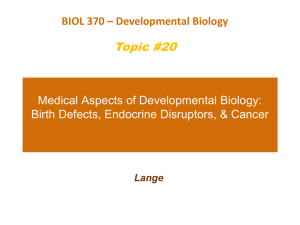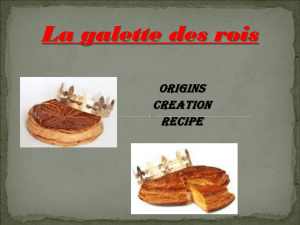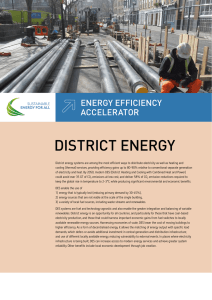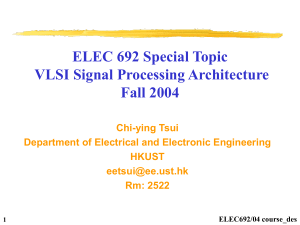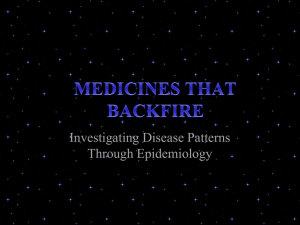Lecture-1 Laissaoui
advertisement
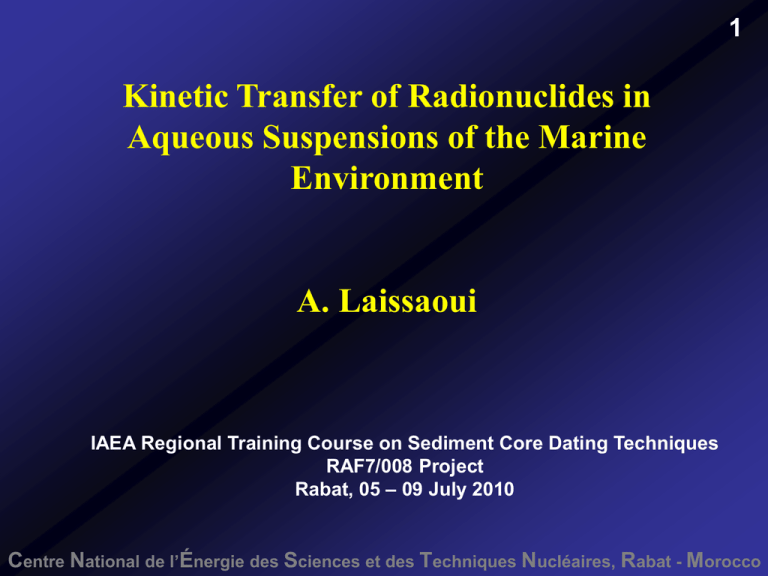
1 Kinetic Transfer of Radionuclides in Aqueous Suspensions of the Marine Environment A. Laissaoui IAEA Regional Training Course on Sediment Core Dating Techniques RAF7/008 Project Rabat, 05 – 09 July 2010 Centre National de l’Énergie des Sciences et des Techniques Nucléaires, Rabat - Morocco INTRODUCTION 2 Aqueous suspension: is a mixture of insoluble particles in water Sorption: partitioning between water and solid phases process in which radionuclides become associated with solid phases Adsorption: process in which a radionuclide becomes associated with the surface of a particle Desorption: the release of radionuclide already associated with particles Why is Sorption Important? - Sorption affects the fate and distribution of radionuclides in the marine environment - Radionuclides behave differently when associated with a solid Centre National de l’Énergie des Sciences et des Techniques Nucléaires, Rabat - Morocco INTRODUCTION 3 Radionuclides pathways is essential for both radioecology purposes and their use as tracers of marine processes The uptake and release by SPM combined with sedimentation and resuspension of the solids play a significant role Reactive transport models were based on the equilibrium distribution coefficients, Kd Steady state condition Recent models are based on kinetic rates of uptake/release of radionuclides between waters and the solid phases when short timescales are involved Centre National de l’Énergie des Sciences et des Techniques Nucléaires, Rabat - Morocco 4 INTRODUCTION Sorption of radionuclides by particles in aqueous suspensions can be regarded as a physico-chemical process Active sites Effect of active sites = Electrical neutrality Exchangeable ions Active sites Ref.: J.M. Abril, 1998. JER Particle Water The most common adsorption reaction in aqueous suspensions is ion exchange R S1 + S2 k1 R S2 + S1 k2 Centre National de l’Énergie des Sciences et des Techniques Nucléaires, Rabat - Morocco The experimental approach 5 The experimental approach consists in spiking the studied suspension to record the time course of the tracer concentrations in the dissolved phase. -Use natural samples -Spiking (analogues) -Permanent Stirring -Control of room temperature -Extraction of aliquots -Separation of SPM from water -Conditioning and measurements The uptake curve Centre National de l’Énergie des Sciences et des Techniques Nucléaires, Rabat - Morocco Application of box models 6 Each box in the model represents a phase and within a particle, sites of different accessibility or energy are represented by boxes. da w = - k .a + k .a 1 w 2 p dt da p = + k1 .a w - k 2 .a p dt k1 Solids ap Water aw k2 k1 .a w (0) - k2 .a p (0) -( k + k a w (t ) = e k1 + k2 ( 1 2 ).t ) - 1 + a w (0) Time evolution of 133Ba conc. in estuarine aqueous suspension (Laissaoui et al. 1998. J. Radioanal. Nucl. Chem.) Centre National de l’Énergie des Sciences et des Techniques Nucléaires, Rabat - Morocco 7 Application of box models Sr-85 conc. in water (Bq/L) 220 220 One-step model 200 200 180 180 160 160 140 140 120 120 0 20 40 60 Time (hours) 80 100 120 Two-step model 0 20 40 60 80 100 120 Time (hours) Sorption kinetics of 85Sr in aqueous suspension (Benkdad et al. 2008. JER). The use of one-step model is a subparametrisation of the real process Centre National de l’Énergie des Sciences et des Techniques Nucléaires, Rabat - Morocco Application of box models 8 Two Parallel and Reversible Reaction Model k11 Water aw da w = -k 11 .a w + k 21 .a s1 - k 12 .a w + k 22 .a s 2 dt da s1 = k 11 .a w - k 21 .a s1 dt da s 2 = k 12 .a w - k 22 .a s 2 dt Site 1 as1 k21 k12 k22 Site 2 as2 [ ( ) ( ) ] aw ( t ) = aw ( t = 0 ). A1 . e P1 .t - 1 + A2 . e P2 .t - 1 + 1 Assumptions: -Discrimination between reactive sites -No intercation between the adsorbed ions -Different species compete for the same sites Centre National de l’Énergie des Sciences et des Techniques Nucléaires, Rabat - Morocco 9 Application of box models k11 (s-1) 0.0018 0.0003 k21 (s-1) 0.028 0.005 k12 (s-1) 0.0172 0.0015 k22 (s-1) 0.35 0.03 kd (l/kg) 19.9 2.1 120 110 Water 100 kd 16 12 8 Site 1 4 Site 2 Kd (l/kg) as1; as2 (Bq/kg) aw (Bq/l) 130 0 0 20 40 60 80 100 120 140 160 Time (hours) Centre National de l’Énergie des Sciences et des Techniques Nucléaires, Rabat - Morocco Application of box models 10 1 Fraction in water 0.8 0.6 Fast slow 0.4 0.2 internediate 0 0.01 0.1 1 10 100 Time (hours) Time evolution of 133Ba concentrations in water (Data from Barros and Abril, 2003) Three-step model involving four compartments Centre National de l’Énergie des Sciences et des Techniques Nucléaires, Rabat - Morocco Application of box models 11 Three-step models Centre National de l’Énergie des Sciences et des Techniques Nucléaires, Rabat - Morocco Application of box models 12 Equivalence between models The fitting parameters are usually obtained from the observed time course of tracer concentrations in the dissolved phase. The same analytical function aw(t) is the solution of the five models Then, the models are mathematically equivalent. once obtained an uptake curve for water concentration, it is not clear to decide which model best describes the adsorption process in a given experiment. What is the physical significance of the kinetic transfer coefficients? Centre National de l’Énergie des Sciences et des Techniques Nucléaires, Rabat - Morocco 13 Effect of SPM concentration Adsorption coefficients are environmental conditions sensitive to changes in 0,16 0,14 k1(h-1) 0,12 0,10 0,08 0,06 Variation of Sr adsorption coefficient with SMC 0,04 0,02 100 200 300 400 500 SMC (ppm) The rate of uptake increases as SPM concentration increases Centre National de l’Énergie des Sciences et des Techniques Nucléaires, Rabat - Morocco 14 Competition effect Activities in site 2 (Bq/kg) 70 C = 0.022 mS 60 50 C = 0.78 mS 40 30 20 C = 21 mS 10 0 1E-3 0,01 0,1 1 10 100 Time (hours) Time evolution of 85Sr activities in particles provided by the two-step model for different conductivities of the solutions (major competitors are Ca2+ and Mg2+). Adsorption is important when cations content is small Centre National de l’Énergie des Sciences et des Techniques Nucléaires, Rabat - Morocco Conlusion 15 Adsorption is important in understanding the behavior of radionuclides in marine environments Desorption is still unpredictable No theoretical aspect could predict the variation of desorption coefficients to changes in physico-chemical properties Experimental efforts are being done to understand desorption Centre National de l’Énergie des Sciences et des Techniques Nucléaires, Rabat - Morocco
